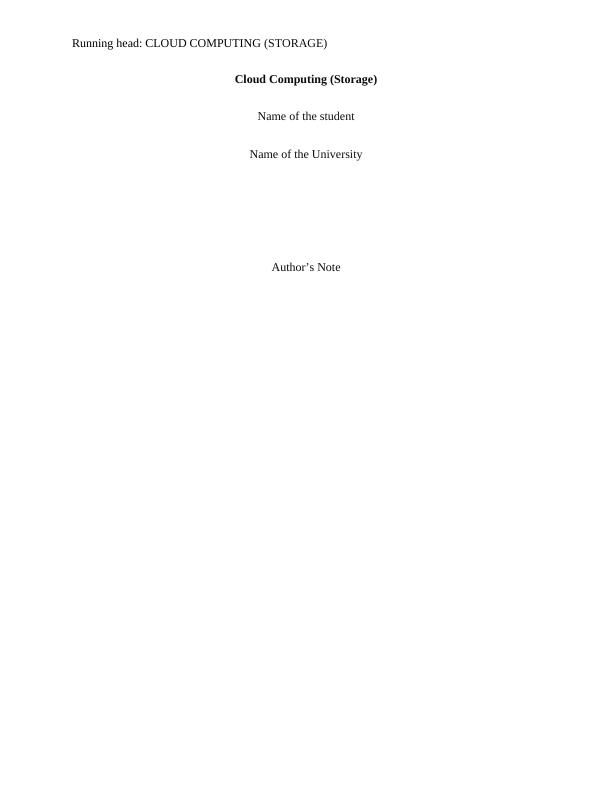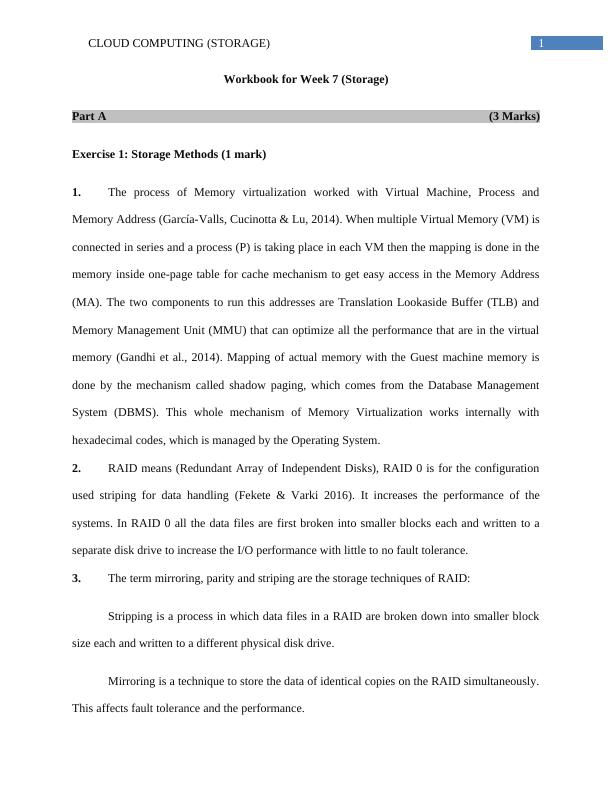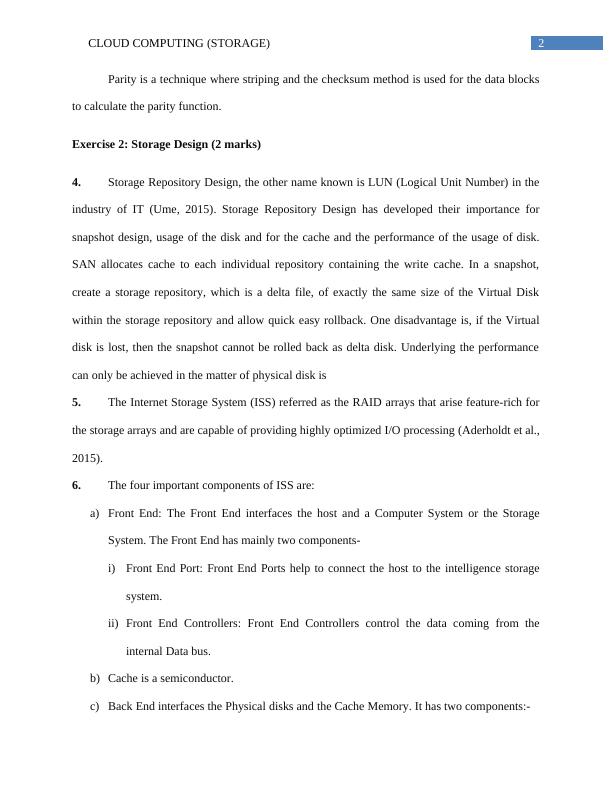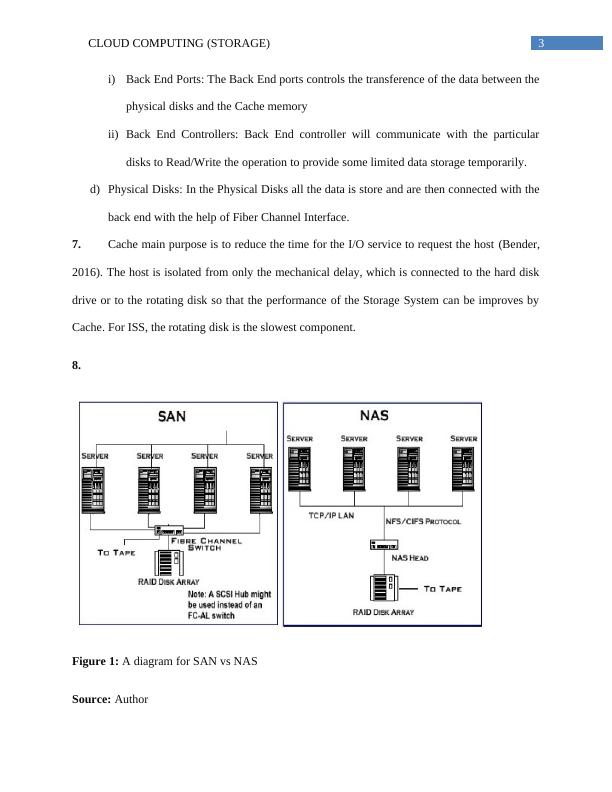Ask a question from expert
Introduction to Cloud Computing (Storage)
11 Pages2155 Words349 Views
Added on 2020-05-28
Introduction to Cloud Computing (Storage)
Added on 2020-05-28
BookmarkShareRelated Documents
Running head: CLOUD COMPUTING (STORAGE)Cloud Computing (Storage)Name of the studentName of the UniversityAuthor’s Note

1CLOUD COMPUTING (STORAGE)Workbook for Week 7 (Storage)Part A (3 Marks)Exercise 1: Storage Methods (1 mark)1.The process of Memory virtualization worked with Virtual Machine, Process andMemory Address (García-Valls, Cucinotta & Lu, 2014). When multiple Virtual Memory (VM) isconnected in series and a process (P) is taking place in each VM then the mapping is done in thememory inside one-page table for cache mechanism to get easy access in the Memory Address(MA). The two components to run this addresses are Translation Lookaside Buffer (TLB) andMemory Management Unit (MMU) that can optimize all the performance that are in the virtualmemory (Gandhi et al., 2014). Mapping of actual memory with the Guest machine memory isdone by the mechanism called shadow paging, which comes from the Database ManagementSystem (DBMS). This whole mechanism of Memory Virtualization works internally withhexadecimal codes, which is managed by the Operating System.2.RAID means (Redundant Array of Independent Disks), RAID 0 is for the configurationused striping for data handling (Fekete & Varki 2016). It increases the performance of thesystems. In RAID 0 all the data files are first broken into smaller blocks each and written to aseparate disk drive to increase the I/O performance with little to no fault tolerance.3.The term mirroring, parity and striping are the storage techniques of RAID:Stripping is a process in which data files in a RAID are broken down into smaller blocksize each and written to a different physical disk drive. Mirroring is a technique to store the data of identical copies on the RAID simultaneously.This affects fault tolerance and the performance.

2CLOUD COMPUTING (STORAGE)Parityis a technique where striping and the checksum method is used for the data blocksto calculate the parity function. Exercise 2: Storage Design (2 marks)4.Storage Repository Design, the other name known is LUN (Logical Unit Number) in theindustry of IT (Ume, 2015). Storage Repository Design has developed their importance forsnapshot design, usage of the disk and for the cache and the performance of the usage of disk.SAN allocates cache to each individual repository containing the write cache. In a snapshot,create a storage repository, which is a delta file, of exactly the same size of the Virtual Diskwithin the storage repository and allow quick easy rollback. One disadvantage is, if the Virtualdisk is lost, then the snapshot cannot be rolled back as delta disk. Underlying the performancecan only be achieved in the matter of physical disk is 5.The Internet Storage System (ISS) referred as the RAID arrays that arise feature-rich forthe storage arrays and are capable of providing highly optimized I/O processing (Aderholdt et al.,2015).6. The four important components of ISS are:a)Front End: The Front End interfaces the host and a Computer System or the StorageSystem. The Front End has mainly two components-i)Front End Port: Front End Ports help to connect the host to the intelligence storagesystem.ii)Front End Controllers: Front End Controllers control the data coming from theinternal Data bus. b)Cache is a semiconductor.c)Back End interfaces the Physical disks and the Cache Memory. It has two components:-

3CLOUD COMPUTING (STORAGE)i)Back End Ports: The Back End ports controls the transference of the data between thephysical disks and the Cache memoryii)Back End Controllers: Back End controller will communicate with the particulardisks to Read/Write the operation to provide some limited data storage temporarily.d)Physical Disks: In the Physical Disks all the data is store and are then connected with theback end with the help of Fiber Channel Interface.7.Cache main purpose is to reduce the time for the I/O service to request the host (Bender,2016). The host is isolated from only the mechanical delay, which is connected to the hard diskdrive or to the rotating disk so that the performance of the Storage System can be improves byCache. For ISS, the rotating disk is the slowest component.8. Figure 1: A diagram for SAN vs NASSource: Author

End of preview
Want to access all the pages? Upload your documents or become a member.
Related Documents
ITECH 2201 Cloud Computing Storage Methods and Designlg...
|6
|1551
|149
Cloud Computing Storage Methods and Design - ITECH 2201lg...
|7
|1808
|298
Network Analysis and Infrastructure.lg...
|14
|2647
|4
Cloud Computing Services Providers Assignmentlg...
|19
|2052
|68